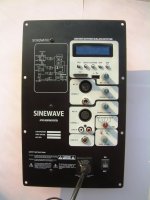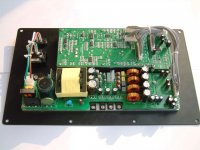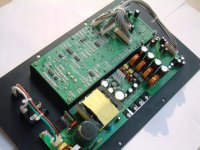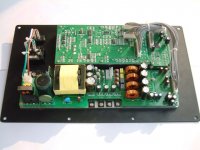I need a decent quality active crossover that is DC powered and has balanced outputs.
And I need 4 high pass channels, 4 band pass channels and 1 low pass channel. I'd consider using a kit, modules or boards if an appropriate all in one unit can't be found.
Here's some more details of what I'm trying to do...
I'm in the planning stage for my next generation bicycle portable sound system.
I pull a home made trailer behind a recumbent tricycle with an electric assist system. The trailer has a PA system and seating for one to four band members. In addition to mobile peformances I also do stationary outdoor parties and events in parks and other locations where volume and decent sound quality are important.
I power everything from rechargeable lithium polymer batteries so efficiency and light weight are almost as important as tolerance for weather & vibration, etc.
Currently I'm considering using four Peavey Impulse 1012 speakers. These are passive 2-way bi-ampable enclosures. I'll also have a single sub-woofer.
I'd like to use ClassDAudio's 600 watt 2 channel amp modules. They are TI-TAS5630 based and can be powered with a single DC rail from 20 to 50 volts. That would be perfect for me because I can use then use the same packs I use to power my trike motor to also power the amps. I'd use four amp modules for the 4 speakers and one bridged for the sub.
The amps use a balanced input. I'd like a DC powered active crossover, but the ones I've found (for car stereo) only have unbalanced RC jack type outputs.
I could go with an AC powered crossover, but for the sake of efficiency I'd rather not if possible. Sometimes I do long events such as century rides where I might play at a low power level for 10 or 12 hours. In these case the extra 5 or 10 watts that might be wasted by an AC crossover powered through an inverter add up (on top of the idle power draws of all the other components). This is also why I'm going through the trouble of using passive speaker enclosures and DC powered class D amplifier modules. Even these high efficiency amp modules suck 7 watts each just for being powered on.
I'd also be interested in hearing suggestions or comments regarding the speakers and amps. My mind isn't made up on anything although the above components are at the high end of my price range, ie about $3k for the complete speaker and amp set.
And I need 4 high pass channels, 4 band pass channels and 1 low pass channel. I'd consider using a kit, modules or boards if an appropriate all in one unit can't be found.
Here's some more details of what I'm trying to do...
I'm in the planning stage for my next generation bicycle portable sound system.
I pull a home made trailer behind a recumbent tricycle with an electric assist system. The trailer has a PA system and seating for one to four band members. In addition to mobile peformances I also do stationary outdoor parties and events in parks and other locations where volume and decent sound quality are important.
I power everything from rechargeable lithium polymer batteries so efficiency and light weight are almost as important as tolerance for weather & vibration, etc.
Currently I'm considering using four Peavey Impulse 1012 speakers. These are passive 2-way bi-ampable enclosures. I'll also have a single sub-woofer.
I'd like to use ClassDAudio's 600 watt 2 channel amp modules. They are TI-TAS5630 based and can be powered with a single DC rail from 20 to 50 volts. That would be perfect for me because I can use then use the same packs I use to power my trike motor to also power the amps. I'd use four amp modules for the 4 speakers and one bridged for the sub.
The amps use a balanced input. I'd like a DC powered active crossover, but the ones I've found (for car stereo) only have unbalanced RC jack type outputs.
I could go with an AC powered crossover, but for the sake of efficiency I'd rather not if possible. Sometimes I do long events such as century rides where I might play at a low power level for 10 or 12 hours. In these case the extra 5 or 10 watts that might be wasted by an AC crossover powered through an inverter add up (on top of the idle power draws of all the other components). This is also why I'm going through the trouble of using passive speaker enclosures and DC powered class D amplifier modules. Even these high efficiency amp modules suck 7 watts each just for being powered on.
I'd also be interested in hearing suggestions or comments regarding the speakers and amps. My mind isn't made up on anything although the above components are at the high end of my price range, ie about $3k for the complete speaker and amp set.
Hi ! I would leave the commercial speakers as they are . Fundamentally the speaker is the less efficient element of the system , ie the energy given (sound pressure) is far less than the electrical one at its input , in any case not more than 5 %. The energy sucked by the passive elements in the splitting frequency network -the crossover-is just a little add-on in this efficiency equation ,and "going active" means a complete revision of all the system components .
All the ones you have chosen make their force by being powered by the mains.
It should be no problem for a little expertized audiofanatic to modify the supply of a line level component such an electronic crossover , but that will be the less problematic part , as also building an unbalanced to balanced converter. Usually they both can be run by 9V (transistor !!!) batteries . The real issues are the amps and the speakers.
If sound pressure is what you're looking for , I suggest you to find many little speakers and mount them in an array : being little , they'll move fast , and require less space , keeping in mind that a subwoofer will do the dirty job.
All the ones you have chosen make their force by being powered by the mains.
It should be no problem for a little expertized audiofanatic to modify the supply of a line level component such an electronic crossover , but that will be the less problematic part , as also building an unbalanced to balanced converter. Usually they both can be run by 9V (transistor !!!) batteries . The real issues are the amps and the speakers.
If sound pressure is what you're looking for , I suggest you to find many little speakers and mount them in an array : being little , they'll move fast , and require less space , keeping in mind that a subwoofer will do the dirty job.
I wasn't planning on doing anything to the speakers. The speakers are passive, no internal amp, so they don't run on mains power. The speakers have two sets of inputs, a 1/4" for using the internal passive crossover and a Neutrik 4 pin for bi-amping.
My expectation is I that when I need high output I would run bi-amped and achieve higher max power, better efficiency and a little better fidelity.
When needing utmost duration from battery power and running at a lower power level I was already considering only using half the amps by paralleling the front and rear speakers. But taking into consideration your point about the fairly low percent losses of a passive crossover I could probably go one step further and not bi-amp, ie just use the input for the passive crossover. In which case I would only need to use the active crossover in a high power situation where the overhead of using an AC powered active crossover is negligible.
As for the choice of speakers, I haven't found smaller speakers that are as efficient. An array of smaller speakers might be able to handle more max watts for less total bulk/weight, but I'm not aware of ones that will put out more SPL per watt, especially at low frequencies just above the subwoofer. And I think speakers with compression drivers and narrow horns project better and give more directional control than arrays of small speakers. But maybe I haven't looked at the right ones. Did you have any specific ones in mind?
Also, when I do stationary outdoor events it's often handy to be able to mount the speakers on tall stands which would likely be more difficult with speaker arrays.
My expectation is I that when I need high output I would run bi-amped and achieve higher max power, better efficiency and a little better fidelity.
When needing utmost duration from battery power and running at a lower power level I was already considering only using half the amps by paralleling the front and rear speakers. But taking into consideration your point about the fairly low percent losses of a passive crossover I could probably go one step further and not bi-amp, ie just use the input for the passive crossover. In which case I would only need to use the active crossover in a high power situation where the overhead of using an AC powered active crossover is negligible.
As for the choice of speakers, I haven't found smaller speakers that are as efficient. An array of smaller speakers might be able to handle more max watts for less total bulk/weight, but I'm not aware of ones that will put out more SPL per watt, especially at low frequencies just above the subwoofer. And I think speakers with compression drivers and narrow horns project better and give more directional control than arrays of small speakers. But maybe I haven't looked at the right ones. Did you have any specific ones in mind?
Also, when I do stationary outdoor events it's often handy to be able to mount the speakers on tall stands which would likely be more difficult with speaker arrays.
Hi ! I would leave the commercial speakers as they are . Fundamentally the speaker is the less efficient element of the system , ie the energy given (sound pressure) is far less than the electrical one at its input , in any case not more than 5 %. The energy sucked by the passive elements in the splitting frequency network -the crossover-is just a little add-on in this efficiency equation ,and "going active" means a complete revision of all the system components .
All the ones you have chosen make their force by being powered by the mains.
It should be no problem for a little expertized audiofanatic to modify the supply of a line level component such an electronic crossover , but that will be the less problematic part , as also building an unbalanced to balanced converter. Usually they both can be run by 9V (transistor !!!) batteries . The real issues are the amps and the speakers.
If sound pressure is what you're looking for , I suggest you to find many little speakers and mount them in an array : being little , they'll move fast , and require less space , keeping in mind that a subwoofer will do the dirty job.
Well , you know acoustics (maybe better than me) and electro acoustics , so just use fantasy + science and put that megaboombox in action !
As far as my beliefs go , I wouldn't use a class D amp on compression drivers,but only for "heavy duty" such a sub. Ideal drivers should be high efficiency , 16 Ohm and this lends to pro-audio. Once you have 4 or 8 drivers , you can try to obtain maximum sound by mounting them two by two in boxes, in OB arrays , in closed dipole arrays ...But I can't go further 'cause I'm limited to home hi-fi which is a little bit different, Yes you can make narrow horns suited for low-midrange so they align with sub's response. Or mount some drivers with the magnet in sight .
In my mind there's a sort of "transformer" , with a big cube which is a folded horn with a 18"-21" inside powered by 500-1000 W , then two "arms" at the sides , which can be moved (rotary) or doubled (miracles of automation!) , or even that can change from closed box with two drivers working , to open boxes with 4 drivers , with a relay to change connections or add another amp.Maybe a low/high power button , in this case the electronic crossover would be also the heart of the system ,changing frequencies (and slopes ) for the different settings...What about a pair of active Mackies ?? HA HA HA
Bye
As far as my beliefs go , I wouldn't use a class D amp on compression drivers,but only for "heavy duty" such a sub. Ideal drivers should be high efficiency , 16 Ohm and this lends to pro-audio. Once you have 4 or 8 drivers , you can try to obtain maximum sound by mounting them two by two in boxes, in OB arrays , in closed dipole arrays ...But I can't go further 'cause I'm limited to home hi-fi which is a little bit different, Yes you can make narrow horns suited for low-midrange so they align with sub's response. Or mount some drivers with the magnet in sight .
In my mind there's a sort of "transformer" , with a big cube which is a folded horn with a 18"-21" inside powered by 500-1000 W , then two "arms" at the sides , which can be moved (rotary) or doubled (miracles of automation!) , or even that can change from closed box with two drivers working , to open boxes with 4 drivers , with a relay to change connections or add another amp.Maybe a low/high power button , in this case the electronic crossover would be also the heart of the system ,changing frequencies (and slopes ) for the different settings...What about a pair of active Mackies ?? HA HA HA
Bye
Look here
http://www.diyaudio.com/forums/class-d/152980-class-d-audio-who-these-guys-11.html
I have use special circuit to get good sound,like this product ,AMP use tas5630,this chip have four channel,BTL has two channel,one for tweeter(50w/80hm/0.1%THD). other for low speaker(220w/40hm/1%THD).excellent sound !
http://www.diyaudio.com/forums/class-d/152980-class-d-audio-who-these-guys-11.html
I have use special circuit to get good sound,like this product ,AMP use tas5630,this chip have four channel,BTL has two channel,one for tweeter(50w/80hm/0.1%THD). other for low speaker(220w/40hm/1%THD).excellent sound !
Attachments
The ClassDAudio amps are full range amplifiers with good specs, they aren't high distortion subwoofer amps. They make a lower powered model with slightly better fidelity (probably a better choice for home hi-fi use) but it requires plus and minus 70 volt DC supplies. For efficiency and weight savings I build custom batteries to meet the power needs of my equipment as opposed to using an additional power supply/converter. The model I selected needs a single 50 volt supply which is easier to do and fits better with my other equipment. Finally I often operate in the rain with huge crowds of people around and I prefer to keep the voltages lower to minimize the chance of anybody getting zapped badly.
I could save a little money and some trouble by simply buying four Mackie SRM450s, but it would appear to be an inferior solution in every aspect that matters to me, SPL, weight, efficiency and fidelity - along with the previously mentioned safety factor/shock risk. And if I wanted to go that approach I wouldn't be asking for advice in a DIY type of forum...
I could save a little money and some trouble by simply buying four Mackie SRM450s, but it would appear to be an inferior solution in every aspect that matters to me, SPL, weight, efficiency and fidelity - along with the previously mentioned safety factor/shock risk. And if I wanted to go that approach I wouldn't be asking for advice in a DIY type of forum...
Well , you know acoustics (maybe better than me) and electro acoustics , so just use fantasy + science and put that megaboombox in action !
As far as my beliefs go , I wouldn't use a class D amp on compression drivers,but only for "heavy duty" such a sub. Ideal drivers should be high efficiency , 16 Ohm and this lends to pro-audio. Once you have 4 or 8 drivers , you can try to obtain maximum sound by mounting them two by two in boxes, in OB arrays , in closed dipole arrays ...But I can't go further 'cause I'm limited to home hi-fi which is a little bit different, Yes you can make narrow horns suited for low-midrange so they align with sub's response. Or mount some drivers with the magnet in sight .
In my mind there's a sort of "transformer" , with a big cube which is a folded horn with a 18"-21" inside powered by 500-1000 W , then two "arms" at the sides , which can be moved (rotary) or doubled (miracles of automation!) , or even that can change from closed box with two drivers working , to open boxes with 4 drivers , with a relay to change connections or add another amp.Maybe a low/high power button , in this case the electronic crossover would be also the heart of the system ,changing frequencies (and slopes ) for the different settings...What about a pair of active Mackies ?? HA HA HA
Bye
Hi ! I was jocking !I could save a little money and some trouble by simply buying four Mackie SRM450s
At the end of 10 periods my mind gets confused and gives an abrupt cut!
So , I was considering the usual trapezoidal shape that allows stacking side by side of multiple boxes ,2 or 3 per side . Those would be the goal : having a box with two drivers and good "behavior". But it might be impractical due to the weight . I suggest to use plastic+lead sheets+felt plus wood where it helps.
If the pressure inside is limited (by using a sub) , the resonances would be kept at reasonable levels.
For the active XO , the song remains the same..
bye
It just so happens I have all the modules you need on my website, pick-n-mix active crossover, balanced i/o and DC splitter 🙂
- Status
- Not open for further replies.
- Home
- Source & Line
- Analog Line Level
- DC powered active Xover w/ balanced outputs?



